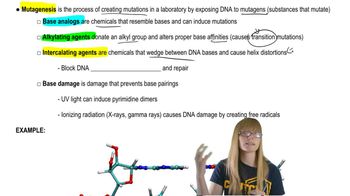Table of contents
- 1. Introduction to Genetics51m
- 2. Mendel's Laws of Inheritance3h 37m
- 3. Extensions to Mendelian Inheritance2h 41m
- 4. Genetic Mapping and Linkage2h 28m
- 5. Genetics of Bacteria and Viruses1h 21m
- 6. Chromosomal Variation1h 48m
- 7. DNA and Chromosome Structure56m
- 8. DNA Replication1h 10m
- 9. Mitosis and Meiosis1h 34m
- 10. Transcription1h 0m
- 11. Translation58m
- 12. Gene Regulation in Prokaryotes1h 19m
- 13. Gene Regulation in Eukaryotes44m
- 14. Genetic Control of Development44m
- 15. Genomes and Genomics1h 50m
- 16. Transposable Elements47m
- 17. Mutation, Repair, and Recombination1h 6m
- 18. Molecular Genetic Tools19m
- 19. Cancer Genetics29m
- 20. Quantitative Genetics1h 26m
- 21. Population Genetics50m
- 22. Evolutionary Genetics29m
17. Mutation, Repair, and Recombination
Induced Mutations
Problem 31
Textbook Question
Textbook QuestionExperiments by Charles Yanofsky in the 1950s and 1960s helped characterize the nature of tryptophan synthesis in E. coli. In one of Yanofsky's experiments, he identified glycine (Gly) as the wild-type amino acid in position 211 of tryptophan synthetase, the product of the trpA gene. He identified two independent missense mutants with defective tryptophan synthetase at these positions that resulted from base-pair substitutions. One mutant encoded arginine (Arg) and another encoded glutamic acid (Glu). At position 235, wild-type tryptophan synthetase contains serine (Ser) but a base-pair substitution mutant encodes leucine (Leu). At position 243, the wild-type polypeptide contains glutamine and a base-pair substitution mutant encodes a stop codon. Identify the most likely wild-type codons for positions 211, 235, and 243. Justify your answer in each case.
 Verified Solution
Verified SolutionThis video solution was recommended by our tutors as helpful for the problem above
Video duration:
2mPlay a video:
427
views
Was this helpful?
Related Videos
Related Practice

